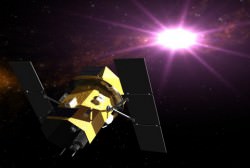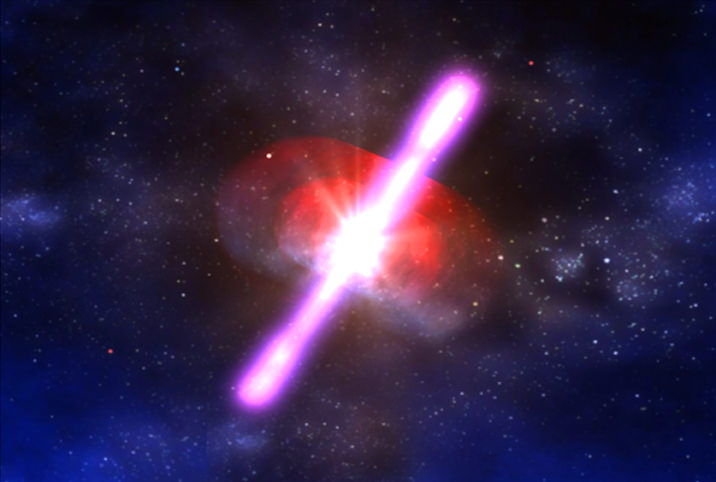[/caption]
Astronomers have now been able to see the very early stages of a gamma ray burst, thanks to the Swift satellite. The Ultraviolet/Optical Telescope (UVOT) on board the satellite provided an ultraviolet spectrum of a GRB just 251 seconds after its onset – the earliest ever captured. Further use of the instrument in this way will also allow distance and brightness of GRBs to be calculated within a few hundred seconds of their initial outburst, as well as gather new information about the causes of bursts and the galaxies they originate from.
“The UVOT’s wavelength range, coupled with the fact that Swift is a space observatory with a speedy response rate, unconstrained by time of day or weather, has allowed us to collect this early ultraviolet spectrum,” said Martin Still from the Mullard Space Science Laboratory (MSSL) at UCL.
“By looking at these earlier moments of gamma ray bursts,” said Paul Kuin, another member of the team, “we will not only be able to better calculate things such as the luminosity and distance of a burst, but to find out more about the galaxies that play host to them and the impact these explosions have on their environments. Once this new technique is applied to much brighter bursts, we’ll have a wealth of new data.”

Massimiliano De Pasquale, a GRB scientist of the UVOT team, added, “The UVOT instrument is particularly suited to study bursts with an average to high redshift – a part of the ultraviolet spectrum that is difficult for even the very big ground-based telescopes to study. Using UVOT with Swift, we can now find redshifts for bursts that were difficult to capture in the past and find out more about their distant host galaxies, about ten billion light years away.”
Since its launch in 2004, the Swift satellite has provided the most comprehensive study so far of GRBs and their afterglows. Using the UVOT to obtain ultraviolet spectrums, the Swift team will be able to build on this study and even determine more about the host galaxies’ chemistry.
Paul Kuin said, “The new spectrum has not only allowed us to determine the distance of the gamma ray burst’s host galaxy but has revealed the density of its hydrogen clouds. Learning more about these far-away galaxies helps us to understand how they formed during the early universe. The gamma ray burst observed on this occasion originated in a galaxy 8 billion light years from Earth.”
Swift is a NASA mission in collaboration with the Science and Technology Facilities Council (STFC) in the UK and the Italian Space Agency (ASI). The work was published on Friday 27th February in the Monthly Notices of the Royal Astronomical society.
Source: Science and Technology Facilities Council


I still can’t believe the luck the UVOT team had with this one. Despite all their laudatios, the UVOT grism spectra are a decidedly bad tool to measure GRB redshifts, not only because the resolution is very low, but especially because they need very bright afterglows to get sufficient signal-to-noise – the integration time is like a minute only, with a 30 cm telescope.
GRB 081203A happened just a few days after they switched to this new mode, and it had a very bright early afterglow, peaking at about 13th magnitude around the time of the spectrum. Perfect conditions.
How long after start do we usually get a read?
Damn, “Artist concept”. You had me going there for a minute. Thank you for labeling it!